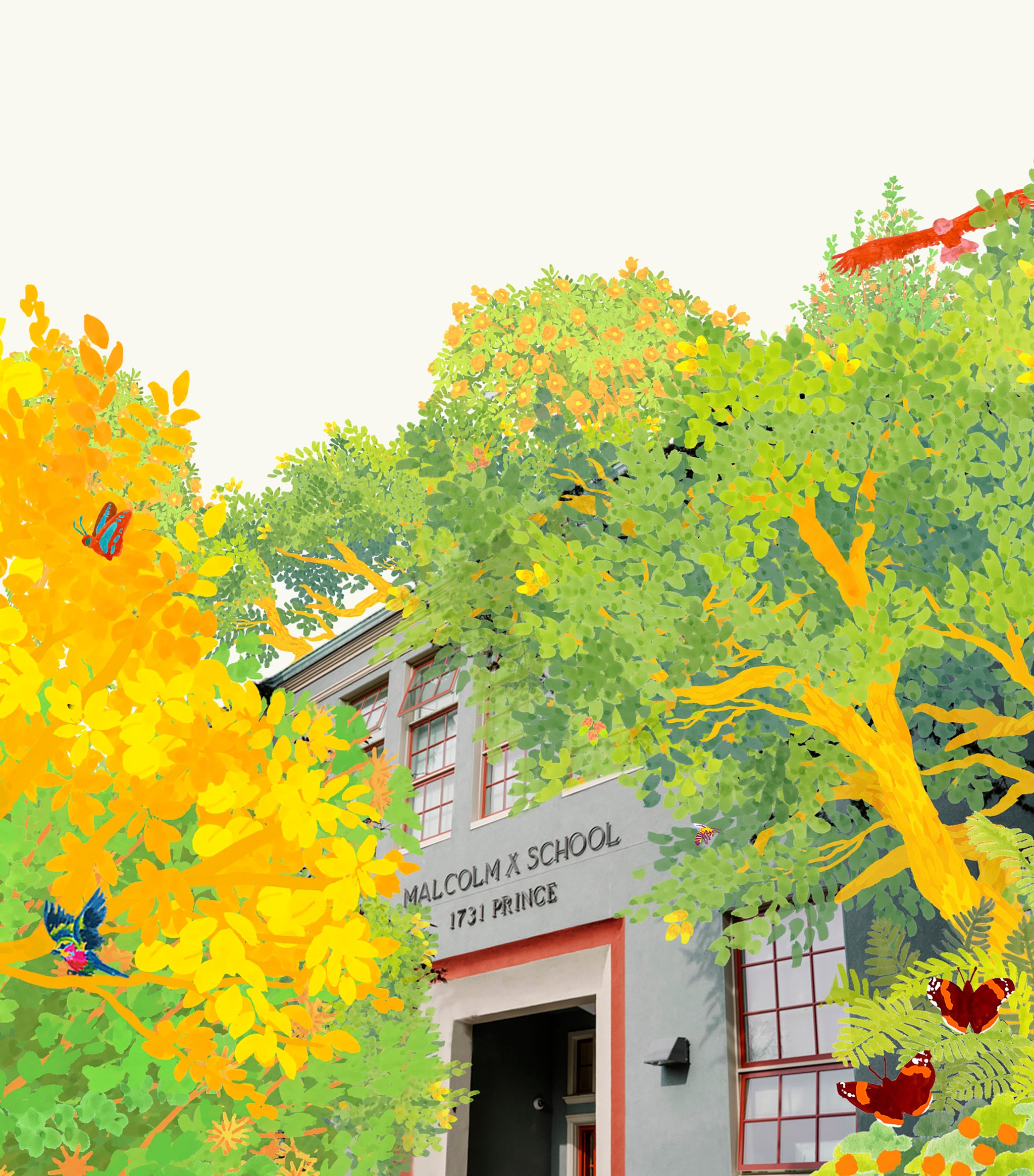Cragmont Elementary
Outdoor Classrooms for East Bay Students.


0
Trees
0
Square Feet
0
Native Species
0
Youth Impacted
Self-sustaining Forest
In November 2021, an unused slope of land at Cragmont Elementary School was transformed into a pocket forest. Now home to native tree species like the Fremont cottonwood (Populus fremontii) and Oregon ash (Fraxinus latifolia), the area has become a sanctuary for local biodiversity.
The resurgence of these native plants has brought a new vibrancy to the school campus, now humming with life. Ladybirds, butterflies, and bees flit through the foliage, while birds like Anna’s hummingbirds (Calypte anna) sip nectar from the twinberry honeysuckle (Lonicera involucrata), and chickadees (Poecile rufescens) feast on rosehips. California blackberry brambles (Rubus ursinus) and native honeysuckle vines weave through the forest, adding bursts of color and texture.
The students are able to observe this diverse ecosystem daily, learning firsthand from Nature and the vital importance of environmental stewardship.
Forest Maker
Ethan Bryson


Forest Partner


Ecosystem Restored
Final report: 28.11.2024
After approximately three years our SUGi Pocket Forests become self-sustaining. They no longer require human maintenance or watering, and can be handed over to Nature for biodiversity and complexity to naturally develop.
0%
Survival Rate
0
People living within 300 meters
0
kg of potential CO2 sequestration
Biodiversity
Biodiversity is all the different kinds of life you'll find in one area—the variety of animals, plants, fungi, and even microorganisms like bacteria that make up our natural world. Each of these species and organisms work together in ecosystems, like an intricate web, to maintain balance and support life.
0
Potential number of mammals
0
Potential number of birds
0
Potential number of amphibians
“I can't say enough about how important this project is for our community and for our children. Most of the time, we just feel powerless as we watch the planet get hotter and experience longer and longer fire seasons in California. This is a very specific and progressive way to sink carbon and change the direction of the planet's temperature rise. I'm excited to include this solution in my curriculum this school year and beyond.“
Ms. Neelam Patil, M.Ed., MFA, Science Teacher at Cragmont and Oxford Elementary Schools
Forest Report: 2023
0 Years
Forest Age
0%
Survival Rate
0m
Average of Tallest 3 Trees
This forest is blossoming. It's located in the center of the elementary school campus, so 350 children are exposed to Nature every day. It's been a STEM learning experience for children. There have been sightings of hummingbirds, chickadees, and towees, as well as various kinds of butterflies, moths, and various species of bees. The native leaf-cutting bees have left evidence of their nest building activities - many leaves have semi circles cut from them.
Leaf litter is building up on the site, as some of the deciduous trees have already shed their leaves, though many of the California native plants are evergreen and will keep their leaves through the winter. The Coyote brush and California sagebrush are doing particularly well, covered in flowers gone to seed. The wood roses had many rose hips, and the California blackberries and native honeysuckle have both sent out long creeping vines.
Biodiversity Notes:
Forest Report: 2022
0 Months
Forest Age
0%
Survival Rate
0m
Average of Tallest 3 Trees
This forest has given students a sense of hope and agency in the face of an alarming acceleration towards the climate crisis. After the planting day last year, students commented: ‘It was the best day of my life.’ Many of the pupils named their plants and, even after a year, still remember exactly which tree they planted and where it was.
The growth of the trees has been exponentially greater than what we could have ever imagined. The forest is now so dense that one can hardly walk through it, and the trees are so tall, you can barely see the tops!
“As the science and climate literacy teacher at Cragmont, it makes me extremely proud to see this tiny project blossoming and bringing so much hope and pure beauty to so many people.“
- Neelam Patil, SUGi Forest Maker
Biodiversity Notes:
Prior to planting, the students would run across the site. It was uncared for, discarded, and unhealthy. Now there are ladybugs, butterflies, bees, and the soil is much healthier and full of life. Local hummingbirds - including Anna’s hummingbird (Calypte anna) come for a snack, and the local flora and fauna is making a resurgence in the area.
Planting: November 2021









































